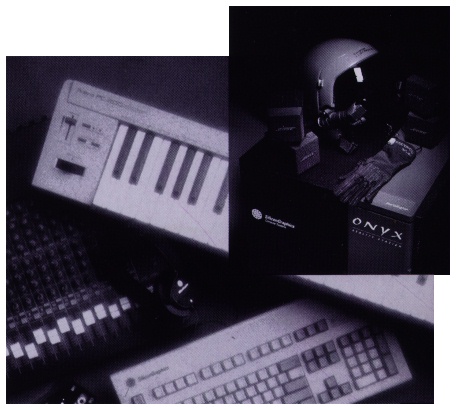The Audio/Serial Option is important for a wide range of application areas, including film and video, virtual reality, visual simulation, and various digital media applications.

The Serial Solution
The serial subsystem of the Audio/Serial Option provides six asynchronous UART ports which transfer data at speeds up to 115 Kbaud, reducing latency for devices such as tablets, headmounted displays, data gloves, and various motion-tracking hardware. For maximum flexibility, RS232 or RS422 protocol is software selectable. Support is provided for hardware or software handshaking.
The Audio Solution
The audio subsystem allows users to record and play multiple channels of audio. Up to four inputs and outputs are supported. The Audio/Serial Option is consistent with the audio capability of Indigo2 and Indy workstations, allowing easy movement of applications between different Silicon Graphics workstations. The Audio/Serial Option is accessed through the Silicon Graphics Audio Library (AL) API.
The Audio Library provides application programs with connections to the audio hardware. The API allows more than one application to "listen to" the audio input source, and more than one application to simultaneously generate audio output.
In addition, the Audio File Library reads and writes AIFF and AIFC digital audio file formats, and performs transparent audio encode/decode using G.711 mu-law and G.722 4:1 algorithms, as well as third-party MPEG and multi-rate audio compression products.
The Audio/Serial Option supports stereo line-level analog input/output and AES/EBU digital input/output, as well as a wide variety of sample rates and the ability to synchronize inputs to other sources. The input and output sample rates are independent.
The Audio/Serial Option may be installed in Reality Station, Onyx, and POWER Onyx graphics supercomputers; CHALLENGE DM, L, and XL network resource servers; and POWER CHALLENGE L and XL supercomputing servers. The Audio/Serial Option connects to these systems via the high-speed I/O interface on the POWER Channel-2 board.
Number of Channels 4 channels 16-bit analog I/O, or
2 channels 24-bit digital I/O
Analog Stereo Line-Level Inputs
Frequency Response +/- 0.81 dB 20Hz to 20kHz
Total Harmonic Distortion
+ Noise at 1 kHz: <0.006% 20Hz to 20kHz maximum: <0.007%
Residual Noise, Unweighted -86dB
Residual Noise, A Weighted -88dB
Interchannel Isolation: 1kHz -82dB
10kHz -72dB
20kHz -67dB
Physical Specifications
Impedance 20kOhm nominal
Amplitude at Full Scale 0.63Vpp to 8.4Vpp
Level Control 2 independent digitally controlled
amplifiers, internal to codecs
Analog to Digital Converter 16-bit, Delta-Sigma
Sampling Rates 32kHz, 44.1kHz, 48kHz, serial digital
input rate, divisors of these rates
Analog Stereo Line-Level Outputs
Frequency Response +/- 1.2dB 20Hz to 20kHz
Total Harmonic Distortion
+ Noise At 1kHz <0.02% 20Hz to 20kHz
Residual Noise, Unweighted -81dB
Residual Noise, A Weighted -85dB
Interchannel Isolation: 1kHz -80dB
10kHz -75dB
20kHz -71dB
Physical Specifications
Impedance 600Ohm nominal
Amplitude at Full Scale 4.7Vpp
Sampling Rates 32kHz, 44.1 kHz, 48kHz, serial digital
input rate, divisors of these rates
Stereo Microphone Input
Frequency Response +/- 0.66dB 20Hz to 20kHz
Total Harmonic Distortion
+ Noise At 1 kHz: 0.0053% 20Hz to 20kHz maximum: 0.0067%
(max occurs at 17.5kHz)
Residual Noise, Unweighted -86dB
Residual Noise, A Weighted -89dB
Physical Specifications
Impedance 1.5kOhm
Amplitude at Full Scale 0.063Vpp to 0.84Vpp
Microphone Power Supply +3V DC, 1mA max
Analog Stereo Headphone Output
Frequency Response +/- 2.3dB 20Hz to 20kHz
Total Harmonic Distortion
+ Noise at I kHz: 0.02% 20Hz to 20kHz maximum: 0.3%
(max occurs at 19.3kHz)
Residual Noise, Unweighted -88dB
Residual Noise, A Weighted -90dB
Interchannel Isolation: 1kHz -87dB
10kHz -76dB
20kHz -73dB
Physical Specifications
Headphone Impedance 10 Ohm
Headphone Level 57mW into 32 Ohm load
Headphone Level Control 2 independent digitally controlled
analog attenuators
Digital Coaxial Serial Input/Output
Input Impedance 75 Ohm, transformer coupled
Input Level 0.5Vpp nominal
Input Sample Rates 30kHz to 50kHz
Output Impedance 75 Ohm, transformer coupled
Output Level 0.5Vpp into 75 Ohm load
Output Sample Rates 32kHz, 44.1 kHz, 48kHz, serial input
rate, divisors of these rates
Resolution Supports up to 24 bits per sample
Coding AES-3, IEC-958
Test Conditions
Unless otherwise stated, all parameters are measured under the
following conditions:
Analog Test Signal Level line in: IVrms, mic in: .IVrms
Analog Test Signal
Output Impedance 600 Ohm
Test Output Destination
Impedance line out: 5K Ohm, headphone out: 150 Ohm
Sampling Rate 48kHz
Measurement Bandwidth 17Hz to 22kHz, unweighted
Digital Test Signal Level 100% of full scale
All connectors are single-ended 3.5mm stereo phone
Serial Subsystem:
Six asynchronous UART ports
TTY compatible
Baud Rate Options
300 2400 19.2K 115.2K
600 4800 38.4K 125K
1200 9600 76.8K
Boot-time configuration parameter in IRIX provides capability to specify trade-off between latency and overhead in servicing the serial ports (2 to 20ms latency).
Both STREAMS-based and shared memory device drivers are available with IRIX for the Audio/Serial Option.
South Pacific (61) 2-879.95.00
Latin America 1(415) 390.46.37
Canada 1(416) 625-4747
Silicon Surf World Wide Web Server
URL: http://www.sgi.com/
Corporate Office
2011 N. Shoreline Boulevard
Mountain View, CA 94043
(415) 960-1980
Copyright 1994 Silicon Graphics, Inc. All rights reserved. Specifications subject to change without notice. Silicon Graphics, and the Silicon Graphics logo are registered trademarks, and Onyx, CHALLENGE, Indigo^, Indy, Reality Station. POWER Onyx, POWER CHALLENGE, POWER Channel and IRIX are trademarks, of Silicon Graphics, Inc. All other products mentioned herein are trademarks or registered trademarks of their respective companies.
CyberGlove provided by Virtual Technologies; Wide Eye Helmet provided by Kaiser Electronics.
Aud-Serlo-DS (01/95)